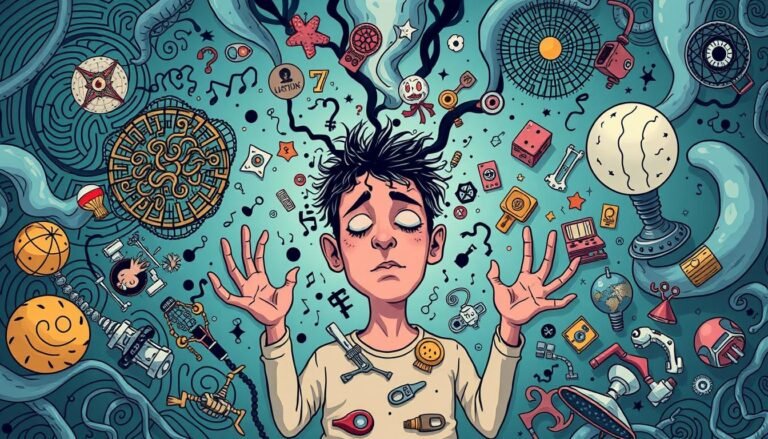Compassion-Focused Therapy (CFT): Healing with Kindness
Can kindness really heal our deepest emotional wounds? This is the core of Compassion-Focused Therapy (CFT), a new way to care for our minds. Paul Gilbert created CFT in the early 2000s. It mixes psychology with kindness to tackle our inner battles.
Gilbert’s work in CFT has made him famous, earning him an Order of the British Empire (OBE) in 2011. His book, “The Compassionate Mind: A New Approach to Life’s Challenges,” came out in 2010. It showed how self-compassion can help us manage our emotions.
CFT combines insights from evolutionary psychology and neuroscience. It helps people deal with painful thoughts and feelings, especially those caused by self-criticism. By teaching self-compassion, CFT offers new ways to heal and grow.
As we delve into CFT, we’ll see how it changes how we see ourselves and others. Let’s embark on this journey to learn about the healing power of kindness in Compassion-Focused Therapy.
Understanding Compassion-Focused Therapy (CFT)
Compassion-Focused Therapy (CFT) is a powerful way to improve mental health. It combines kindness with science. It helps people manage tough emotions and be kinder to themselves.
Definition and Core Principles of CFT
CFT teaches us to be more compassionate. It focuses on understanding our feelings and being kind to ourselves. This therapy usually lasts 8 sessions and can be used with other therapies like Acceptance and Commitment Therapy (ACT).
Origins and Development by Paul Gilbert
Paul Gilbert, a British psychologist, created CFT in the early 2000s. He saw that many people struggled with shame and self-criticism. Gilbert developed CFT to help with these issues.
The Role of Evolutionary Psychology and Neuroscience
CFT uses evolutionary psychology and neuroscience. It explores how our brains evolved and why we get stuck in negative patterns. This helps people achieve emotional balance.
Studies show CFT is effective. A 2012 study found it better than usual treatments for depression in psychosis patients. It also helps with mood disorders, eating disorders, and anxiety. While more research is needed, CFT offers hope for emotional challenges.
The Three Emotion Regulation Systems in CFT
Compassion-Focused Therapy (CFT) identifies three main emotion systems. These systems help us survive and grow. But, life experiences can make them unbalanced.
Threat and Self-Protection System
The threat system alerts us to dangers. It makes us feel fear, anger, and anxiety. For some, it can always be on high alert, causing stress and worry. CFT works to better manage this system.
Drive and Excitement System
The drive system pushes us to get rewards and reach goals. It brings excitement and pleasure. But, too much can cause burnout or addiction.
Contentment and Social Safeness System
The contentment system brings peace and social connection. It’s often weak in those with mental health issues. CFT aims to boost this system for calm and self-compassion.
Knowing these systems is key to mental balance. CFT teaches us to balance them for better mental health.
| Emotion Regulation System | Primary Function | Associated Emotions | CFT Focus |
|---|---|---|---|
| Threat System | Detect and respond to dangers | Fear, anger, anxiety | Reduce overactivity |
| Drive System | Motivate and achieve goals | Excitement, pleasure | Balance with other systems |
| Contentment System | Promote well-being and social connection | Peace, calmness | Strengthen and activate |
Key Techniques and Exercises in CFT
Compassion-Focused Therapy (CFT) uses many powerful methods to build self-compassion and emotional health. At its heart is compassionate mind training, helping people treat themselves with kindness.
Mindfulness is key in CFT. It helps people notice their thoughts and feelings without judging. By staying in the present, they learn to see their inner world with curiosity and acceptance.
Compassion-focused imagery is also vital. It involves creating mental pictures that bring warmth, safety, and kindness. Patients might picture a caring figure or a peaceful place.
- Writing compassionate letters to oneself
- Building a compassionate self-image
- Practicing self-soothing techniques
- Engaging in appreciation activities
These activities aim to activate the soothing system, balancing threat and drive systems. Regular practice helps build a compassionate mindset. This reduces self-criticism and boosts emotional strength.
“Compassion is not a relationship between the healer and the wounded. It’s a relationship between equals.” – Pema Chödrön
CFT also looks into the roots of self-criticism, helping patients fight negative self-talk. With regular practice, these methods can greatly improve mental health and overall well-being.
Benefits and Applications of Compassion-Focused Therapy
Compassion-Focused Therapy (CFT) is a powerful tool for mental health. It helps people build shame resilience and fight self-criticism.
Addressing Shame and Self-Criticism
CFT changes harsh self-talk into kinder words. It boosts self-compassion, reducing shame and self-criticism. Studies show it’s especially good for treating depression that doesn’t respond to other treatments.
Treatment for Mood Disorders and Anxiety
CFT has shown great results in treating anxiety and mood disorders. A study found that combining CFT with mindfulness reduced symptoms in patients with chronic depression.
Potential for Eating Disorders and Psychosis
Research is also looking into CFT for eating disorders and psychosis. It aims to help people develop a kinder relationship with themselves. This could lead to better mental health across different conditions.
| Condition | CFT Effectiveness |
|---|---|
| Treatment-Resistant Depression | 33% recovery rate in study group |
| Anxiety Disorders | Significant reduction in symptoms |
| Eating Disorders | Promising initial results |
| Psychosis | Positive outcomes in symptom management |
CFT is a versatile therapy for many mental health issues. It focuses on building self-compassion and emotional control. This offers hope for those dealing with ongoing mood disorders and anxiety.
The Science Behind CFT: Attachment Theory and Mindfulness
Compassion-Focused Therapy (CFT) uses attachment theory and mindfulness. It’s based on the science of compassion. Studies show it reduces stress and improves health.
Attachment theory explains how early relationships shape our connections. CFT helps people develop self-compassion. This can make relationships better and increase self-awareness.
Mindfulness in CFT helps clients notice their thoughts and feelings. This is key for healing and growth. Being kind to oneself can lead to higher achievements than being too hard on oneself.
Research shows that shame can block feeling safe and forming close bonds. CFT works to overcome this by teaching self-compassion.
| Aspect | Impact of CFT |
|---|---|
| Stress Reduction | Decreased tension, improved health |
| Achievement | Higher levels compared to self-criticism |
| Relationships | Enhanced connections, improved self-awareness |
| Emotional Regulation | Improved access to soothing systems |
In the last 15 years, CFT has helped many. It’s used by both new and experienced therapists. This shows its growing role in mental health care.
Conclusion: The Future of Compassion-Focused Therapy
Compassion-Focused Therapy (CFT) is changing the game in psychotherapy. Recent studies show it’s really working. A 2023 meta-analysis of 15 studies found CFT boosts self-compassion and reduces self-criticism. It also helps with depression and eating disorders.
The future of CFT is looking good. A study by Jazaieri et al. (2013) showed we can teach compassion. This means new ways to treat mental health issues. CFT has been shown to improve resilience, mindfulness, and life satisfaction.
As we move forward, CFT’s uses will keep growing. It’s being studied for treating bipolar disorder, psychosis recovery, and substance use disorders. With more research and better techniques, CFT will be a key player in mental health healing and well-being.
Source Links
- Compassion–Focused Therapy
- What to Know About Compassion-Focused Therapy?
- What is Compassion Focused Therapy and how does it work?
- Compassion-focused therapy
- Your Brain’s 3 Emotion Regulation Systems | Learn to Soothe Yourself
- Compassion-Focused Therapy (CFT)
- CFT Matrix | Compassion Focused Therapy Matrix — Therapy through the ACT Matrix
- Compassion Focused Therapy (CFT) – Psychology Tools
- Compassion-Focused Therapy: Expert Help & Healing | Thriveworks
- Frontiers | Benefits of group compassion-focused therapy for treatment-resistant depression: A pilot randomized controlled trial
- Benefits of group compassion-focused therapy for treatment-resistant depression: A pilot randomized controlled trial
- Compassion-Focused Therapy (CFT) | Charlie Health
- Compassion Focused Therapy — Dr. Kari Killianey
- Mindfulness and Compassion Focused Therapy for Everyone
- Psychotherapeutic benefits of compassion-focused therapy: an early systematic review
- A Narrative Review of Compassion Focused Therapy on Positive Mental Health Outcomes
- Introducing compassion-focused therapy | Advances in Psychiatric Treatment | Cambridge Core








